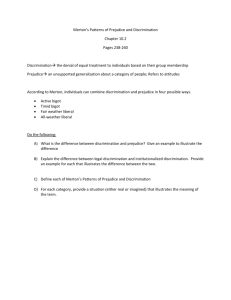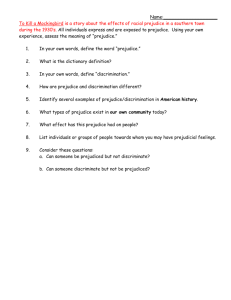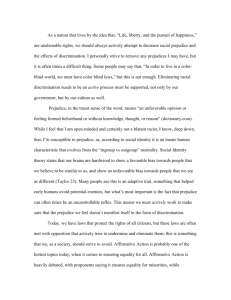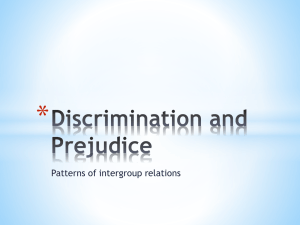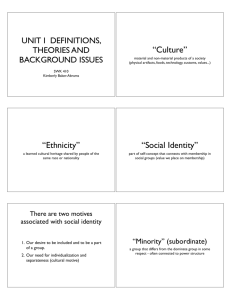Discrimination - Twinsburg Schools
advertisement
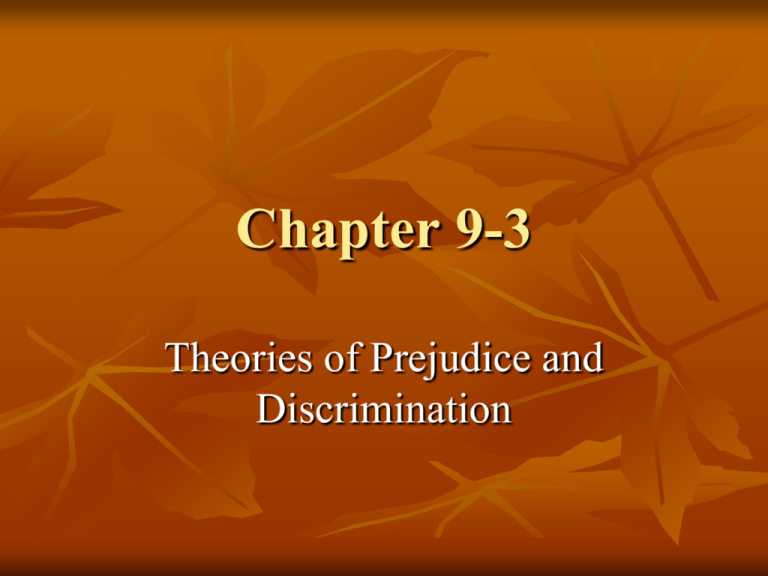
Chapter 9-3 Theories of Prejudice and Discrimination Discrimination & Prejudice Discrimination: the denial of equal treatment to individuals based on their group membership Involves behavior Prejudice: unsupported generalizations about a category of people Involves attitudes Discrimination Found on an individual or societal level Individual Level: name calling, rudeness, acts of violence (1,170 blacks lynched between 1882-1970 in the US) Societal Level: legal discrimination and institutionalized discrimination Legal Discrimination Sanctioned by laws Apartheid, voting rights, Jim Crow Laws Institutionalized Discrimination More resistant to change Over time, unequal access to resources push minority groups into less powerful positions Doesn’t require conscious discrimination by the dominant group to maintain inequality Becomes part of the social structure Institutionalized Discrimination EXAMPLE: Blacks denied housing/jobs because of prejudice become concentrated in low income areas schools are poorly funded children don’t gain education to compete for good jobs can’t move to good neighborhoods cycle of inequality continues…. Prejudice Stereotype: oversimplified, exaggeration or unfavorable generalization about a group of people Irish, Jews, “Hillbillies” etc. Prejudice Self Fulfilling Prophecy: a prediction that results in behavior that makes the prediction come true Told enough that you are stupid, you believe it and live it Racism: the belief that one’s own race or ethnic group is naturally superior Can lead to slavery or genocide Sources of Discrimination & Prejudice Sociological Explanation: focus is on the social norms and the socialization process internalize prejudice Economic Explanation: focus is on competition for scarce resources Jobs for Chinese vs. whites Sources of Discrimination & Prejudice Psychological Explanation: focus on individual behavior May have a particular type of personality prone to discrimination Also done through scapegoating (blame someone for your problems because you feel superior) Examples? Merton’s Patterns of Prejudice & Discrimination YES NO Prejudice TIMID BIGOT: NO Discrimination ALL WEATHER prejudiced but LIBERAL: nonprejudiced who doesn’t doesn’t discriminate discriminate ACTIVE BIGOT: FAIR WEATHER prejudiced who LIBERAL: nonYES discriminates prejudiced who discriminates Functionalist Perspective • Negatives: The social, political, educational, and economic costs to society are extremely high The safety and stability of the larger society are at risk due to violence • Positives: • The self-concepts within the majority group are strengthened due to a feeling of superiority Conflict Theory • A majority uses prejudice and discrimination as weapons of power to control a minority • increase control over property, goods, and other resources • Minorities view each other as competitors instead of allies in the struggle against the majority Symbolic Interactionist Members of a society learn to be prejudiced Two stages: Pregeneralized learning period—children overhear parents making racist statements, but they have not yet learned to separate people by race or ethnic group Total rejection stage—children can use physical clues to sort people into groups
